
 |
| Shortcuts: archive context original video original music trial the film user examples after technoviking |
||
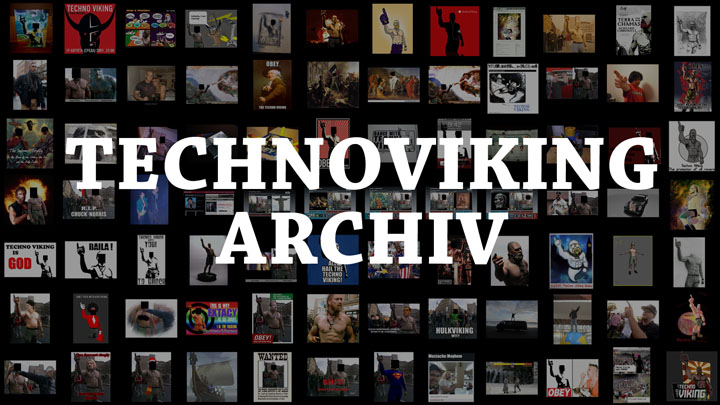 |
||
| TECHNOVIKING ARCHIVE Archive for research on the Technoviking Meme, 2000-2025 |
||
Matthias Fritsch researched the internet history of his video Kneecam No.1 aka Technoviking from it's production until it became a popular Internet Meme with more than 200 million documented clicks on the internet and many thousand directly related video responses on YouTube and other social media platforms. Today, the archive includes well over 4.000 units and 90 GB of data in the form of more than 2.000 images, collages, emails, blogs, forum discussions, and a selection of approximately 1.500 hand-selected video reactions, organized into more than 70 categories to illustrate the various approaches of recycling culture on the social web. Because of the results of a trial (personality rights versus freedom of art) that was initiated by the men, whos image and person was labeled in the Internet as The Technoviking, neither the original video nor the full archive are available for public anymore. The less risky examples from the archive are published in form of mashups or installations of the archive and lectures where Fritsch also shows some of the most interesting video responses. The artist illustrates new ways of production and distribution within user generated networks. From his experiences on the Technoviking Phenomenon Fritsch developed his following Work Music from the Masses. |
Ever since the attention on the video's countless user-versions is high up and hundreds of remix versions and responses to the video are still being published in the internet. Fans continue to imitate the video's dramaturgy and re-enacted it in their homes, in clubs or on the streets. A selection of transformations and re-enactments was published on the website Technoviking.tv. For educational purposes Fritsch is touring to festivals and conferences in order to present his research on the meme and to talk about the internet's user culture. In 2015 a feature length documentary was produced with lots of contributions from the archive and ca. 30 expert interviews. Author: Carmela Thiele, Corso, DLF Köln aired on May 5th, 2009 listen here to an other feature on Corso (German) Author: Eva Raising, Corso, DLF Köln aired on September 10th, 2013 |
|
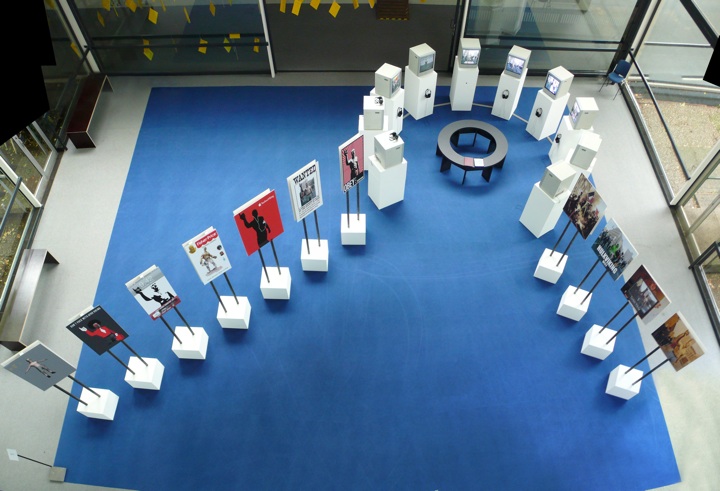 Installation of the Technoviking-Archive in Nancyhalle, Karlsruhe, Germany, 2009 Basic Concept by Matthias Fritsch und Annabel Lange, Design & Installation by Oliver Boeg / Team Wahlheimat |
||
The Techno VikingThe Techno Viking is a tall, muscular, charismatic, intimidating German man in his 30ies, that danced in front of the camera at the Fuckparade in Berlin in 2000. The Fuckparade emerged as a reaction to the music restriction (e.g. the exclusion of other techno styles as Gabber, Speedcore, Hardcore Techno or Punk music) of the Berlin Love Parade and its increasing commercialization, as well as a public demonstration against the shut down of the famous techno club "Bunker," (which serves as a home for a private art collection today.) |
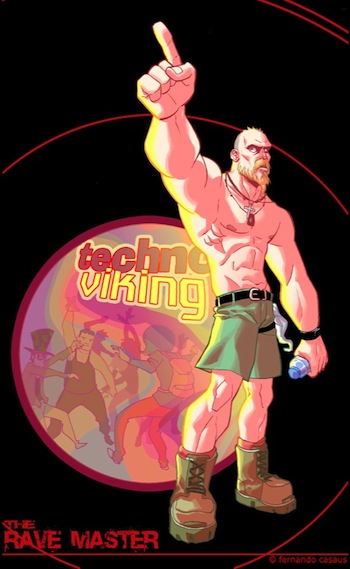 |
|
The Context |
||
| The Techno Viking project is an example for the reordering, reediting and remaking of an "original" video in the internet. The original video is in analogy to genes called a meme. As such the original and its first clones, start to circulate within social networks, where the original mutates, competes with other originals and inherits. Becoming multiplied in this way, the original video becomes successful by reproducing itself, through various recycling techniques. In this way the Techno Viking project questions the creation's origin of such an internet hype. The popular result is not the beginning, but the the original + n, after being altered and filtered several times through a chain of actions and reactions. |
The potential of public attention such clips raise, brings also attention to the role of such major companies as Google. Google as the owner of YouTube provides the basic technological structure not only to enable and control, but also to profit from such creations. If the creation is based on "free" social information networks, the product is commercialized through a monopole company. In this way the Techno Viking is a perfect example to illustrate such new ways of production and distribution within user generated networks. | |
|
What is the video of TECHNOVIKING?It is a short art video produced by Matthias Fritsch at the Fuckparade in Berlin on July 8th 2000. It's original title is "Kneecam No.1." The video was the first in a series of art videos that focused on the role of the camera and questioned reality and human perception. It was raising the question if the sequence is real or staged since it's dramaturgy and way of filming blurs the border between fiction and documentary. In 2007 the video was discovered by the YouTube community and posted by users in various other platforms. After being linked and discussed in different web sites and internet forums it got uploaded by user "BigCat8" on break.com, a big american media portal "for guys" where the video had it's peak on September 28th 2007 with 2 million viewers over night. In the following 6 months the Video got more than 10 Million clicks under the new name of "Techno Viking". The video became an Internet Meme. |
|
The Original Music |
||
| There are hundreds of Technoviking videos with all kind of music in the internet, but originally the DJ in the background played two techno tracks and after years of searching fans tracked down the originals: Track 1: Artist: Can-D-Music Album/Track: Navigator Label: Low Spirit Recordings 1999 |
Track 2: Artist: Winstan vs. Noia Track: Save Changes And Exit Album: Auto Detect EP Label: 4sale Recordings Genre: Electronic Style: Techno Year: 2001 |
|
The Technoviking Trial |
||
| Around christmas 2009 the technoviking video's main protagonist sent a lawyer to the filmmaker in order to stop all further publication of his film "Kneecam No.1". He claimed that the video was produced, published and used for merchandising without his consent and that he would be loosing jobs because of the Technoviking's fame and on top of that being approached by political right wing oriented people who also abuse his image. At that time the clip was already out of the filmmakers control for years. It existed with hundreds of copies all over the web. It is true that within 2 years until the plaintiff send his 1st lawyer to the filmmaker, the artist had earned in total around 10.000 Euro in connection with the meme's popularity. 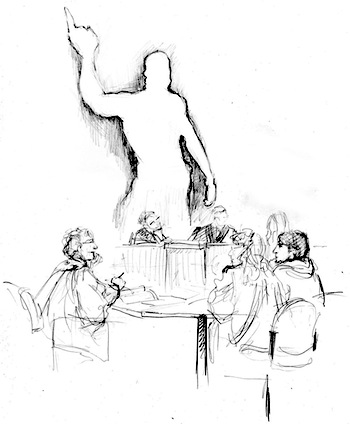 |
The amount resulted basically from YouTube Advertisements and to a small part from TV-licenses and T-shirts sales. From the beginning of the negotiations the filmmaker offered to share all profits made connected to the technoviking meme. He further expressed to be open to discuss together future options on how to market the meme's success. There have been many requests from event and production companies that were interested in the Technoviking but nobody was able to find the real person behind, not even the filmmaker himself. In the beginning of 2010 Fritsch stopped all commercial activities that were connected to the original video or the plaintiff's image, he blocked the original video on YouTube with annotations and limited the use of images that show the real persona to an only internal and offline use within the Technoviking archive. Still it was not possible to find a compromise outside court and in early 2010 the video's protagonist announced that he would take the case to court. Nothing happened for almost three years until at the end of 2012 the plaintiff finally suit the film maker, short before the case would have been expired. He also demanded financial compensation.The trial began in the middle of january 2013 in Berlin. The judges suggested a settlement between the two parties that was in favor of the plaintiff but he didn't accepted. End of May 2013 the 3 judges at Berliner Landgericht pronounced a judgement. As a result it will not be allowed anymore to show the original video as long as it is possible to identify the protagonist. The filmmaker Matthias Fritsch is facing a fee up to 250.000 Euro or up to 6 months of jail time in case of violating the judgement. Additional the filmmaker has to pay the money that he had earned completely to the plaintiff. The judges denied the plaintiff any further financial compensation for personal suffering and concluded that he would be after the money and by waiting for almost 3 years not consequent trying to solve his argued problems. At the End of July 2013 the plaintiff appealed to the judgement and takes the trial a step further to Kammergericht Berlin which is one level below the constitutional court in Germany. |
|
The Documentary Film |
||
| Matthias Fritsch produced a 90min documentary film about the Story of the Technoviking Meme that tries to explain how the Meme was created and triggers big questions that come up when our fundamental rights get in conflict with each other. How should we deal with the contemporary dilemma of intellectual property in a time of collective creation that gives birth to phenomena such as the Technoviking Meme. |
The Filmmaker hosted a Crowdfunding Campaign on the platform Indiegogo in summer of 2013. The project was supported by ca. 300 people from 18 countries. The film was published online for free in October 2015 in a short version of 50min on vimeo. |
|
| The work on the film wouldn't be possible with the generous support of these people: Achilleas Kentonis, Akeli Mieland, Aksioma - Institute for Contemporary Art, Alessandro Drescher, Alessandro Ludovico, Alex Kozina, Alexander Bootz, Alexander Lacher, Alexander Lauert, Alexander Schibalsky, Alexandros Salapatas, Almut Ilsen, Anastasia Chrysanthakopoulou, Andreas Hübner, Andreas Huth, Andreas Kotes, Andreas Krüger, Andreas Schuster, Angela de Weijer, Anna Heinzig, Annabel Lange, Annet Dekker, Antonio Gonzales Paucar, Arjon Dunnewind, Armin Mobasseri, Barbara Seelig, Benjamin Meier, Benjamin Zierock, Carmen Billows, Carmen von Schöning, Carsten Stabenow, Carsten Wagner, Carsten Wilhelm, Chris Piallat, Christian Bucher, Christian Claus, Christian Palmizi, Christoph Knoth, Christoph Schwerdtle, Christoph Wermke, Christoph Willems, Chrysovalantou Karga, Claudia Schuster, Claudia Wittmann, Clemens Lerche, Clemens Wistuba, Dale Greer, Daniel Fabry, Daniel Krönke, Daniel Memhardt, Daniel Rakete Siegel, Daphne Dragona, David Schmidt, David Wnendt, Davinder Sandal, Dieter Sellin, Dieter Vandoren, Dina Boswank, Dirk Unger, Dominik Halmer, Dorna Safaian, Ed Marszewski, Eduard Stürmer, Elias Scheideler, Elizabeth Wurst, Elvira Heise, EMAF Festival, Eno Henze, Eugen Wasin, Evgenia Palla, Federico Bassetti, Federico Missio, Fee Plumley, Felix Dittmar, Felix Grünschloß, Felix Herrmann, Felix Vorreiter, Florian Blum, Florian Geierstanger, Frank Botermann, Frank Dietrich (Zechnick Himmelfaart), Franz-Josef Schmitt, Fufu Frauenwahl, Gabriele Voehringer, Geoffroy Ribaillier, Giorgio Giardina, Gordan Savicic, Guillermo Federico Heinze, Günter Kuhns, Hannah Cooke, Hannes Kiesewetter, Heidrun Fritsch, Henning Arnecke, Hermann Noering, Iain Cozens, IMPAKT Festival, Ines Wuttke, Ioannis Arvanitis, Ira Schneider, Isaak Broder, Ivan Shakhov, James Redfern, Jan Katsma, Jelena Colic, Jens Gerstenecker, Joachim Steinigeweg, Johan Weigel, Johanna Hoetjes, Johannes Fritsch, Johannes Marx, John Butler, John Deamer, Jose Diego Ferreiro, Juergen Eckloff, Julia Jochem, Julius Schall, Karolina Serafin, Katerina Gkoutziouli, Kathleen Rappolt, Katrin Duffke, Kathrin Keller, Kenny Stanger, Kieran Black, Kika Kyriakakou, Kilian Ochs, Klaus Neumann, Lars Thraene, Lea Gscheidel, Leopold Solter, Lucio Basadonne, Magdalena Vollmer, Manuela Putz, Marc Kanzenbach, Marco Melluso, Marco Trotta, Maren Kiessling, Margret Olafsdottir, Maria Konioti, Mark Braun, Markus Wende, Martin Diering, Martin Heinze, Matthew Denton, Matthias Matanovic, Maurits Boettger, Melanie Jilg, Michael M. Dreisbach, Michael Pierce, Miguel Ribeiro, Mischa Kuball, mursu909, Nadin Tettschlag, Nick Cripps, Nicolas Stumpf, Nikos Dimitrakakos, Nils Menrad, Oliver Schmid, Pat Amoesta, Patricia Röder, Patrick Krolzik, Peter Gräser, Philipp Engelhardt, Philipp Hahn, Philipp Scholz, Reimar Servas, Reinhard Bock, René Lamp, Rikard Bremark, Robert Lippok, Robert Utech, Roland Dreger, Ronald The, Ronnie Grob, Rupert Hoffschmidt, Sabine Koziol, Sam Schlatow, Sancto Russell, Sandra Fauconnier, Scott MacFiggen, Sebastian Felzmann, Sebastian Standke, Sigurd Bemme, Siim Leetberg, Simon Ruschmeyer, Sina Dunker, Sonja Möse, Stamatis Schizakis, Stefan Fischer, Stefan Frielingsdorf, Stefan Kilz, Stefan Schubert, Stefano Simone, Stephan Kaempf, Stephan Probst, Stephen Kovats, Susanna Jerger, Ted Sonnenschein, Thomas Kupser, Thomas Mühlberg, Thomas Müller, Thomas Reiner, Tidi Tiedemann, Tillmann Allmer, Tilmann Vogt, Tim Pritlove, Tim Waters, Timo Haubrich, Timo Kaerlein, Timo Steuerwald, Timothy Wenzel, Tobias Kraft, Tobias Wootton, Torsten Landsiedel, Ulf Aminde, Vijay Mirpuri (ACID BUDA), Wolfgang Fritsch, Wolfgang Senges, Wolfgang Ullrich, York Wegerhoff |
||
User Examples |
||
Following a selection of the most interesting and popular video responses, due to the judgement within the technoviking trial its not possible to directly link to those examples anymore: |
The people's fascination with Techno Viking's dancing skills create group choreographies and the Techno Viking character even finds his way into the 3D worlds like "Mattias Techno Viking", where the Techno Viking like character "Mattias" from the shooter "Mercenaries" was animated to the exact dance moves of the meme, various re-enactments in virtual worlds like World of Warcraft, Minecraft, Skyrim and others. See a selection of transmedia user-examples in the video below! The combination of one meme with another can raise the attention within the fan community by creating overlapping interest. Examples are the use of Vernon Koekemoer and Chuck Norris in a "Streetfighter" lookalike clip "Technovikiung vs. Vernon Koekemoer" and other collages using memes like "Little Indian Boy" or the main character of the cult movie "300" The users by far biggest recycling strategy is the simple change of the soundtrack without doing much with the video layers. There the Techno Viking clip was combined with all kinds of music genres like dubstep, folk music, 80ies classics, metal, elektro, pop etc. |
|
After Techno Viking |
||
| From the experience with the TechnoViking phenomenon and by using the user's most popular recycling strategy – the replacement of the videos soundtrack to an other music piece – Fritsch developed the Work "Music from the Masses." Following a five year schedule he started to publish silent movies in the internet along with an open call for composers, musicians, sound designers and everybody else to create soundtracks accompanying the silent clips. The submitted contributions are published in the web in combination with the video as music clips. The work is an open edition and will not have a calculated end. It will be furthermore possible to always add new compositions and variations. This generic model of recycling and resembling is producing a situation that can be called "Youtube-Reality." It is a reality where the setting of an original identity is in constant and uncontrollable aesthetic modification. For more information go to the project |
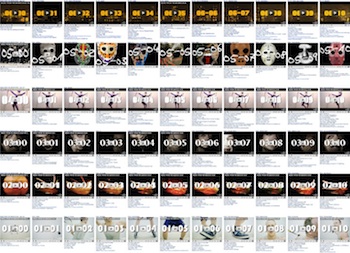 |
|